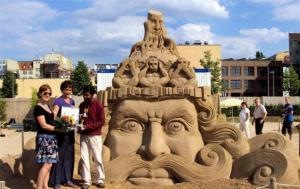
Tagore with Einstein in 1941
Rabindranath Tagore, the first Nobel laureate poet, writer, philosopher was the ambassador of Indian culture to the rest of the world. Tagore was the first Asian person to be awarded with the Nobel Prize in 1913.
Tagore’s multifaceted talent showered upon different branches of art, such as, novels, short stories, dramas, articles, essays, painting etc. And his songs, popularly known as Rabindrasangeet, have an eternal appeal and are permanently placed in the heart of the Bengalis. He was a social reformer, patriot and above all, a great humanitarian and philosopher. India and Bangladesh – the national anthems of these two countries are taken from his composition.
The world celebrates the 150th birth anniversary of Rabindranath Tagore this year. Tagore forms a trinity along with the Sanskrit poet and playwright Kalidas and Hindi poet and philosopher Goswami Tulsidas.
Rabindranath Tagore has a message for mankind. His poems and essays provide a way to tackle the challenges that the world is facing today. This could be viewed in the context of conservation of environment; threats to world peace; and ways to expand the human mind and its potential.
Rabindranath Tagore believed that true democracy and freedom alone would lead to realisation of the full potentialities of human beings. It was in this context, that he emphasised freedom of the mind. A poem in Gitanjali catches this ethos admirably:
Where the mind is without fear and the head is held high;
Where knowledge is free;
Where the world has not been broken up into fragments by narrow domestic walls;
Where words comes out from depth of truth;
Where tireless striving stretches its arms towards perfection;
Where the clear stream of reason has not lost its way into the dreary desert sand of dead habit
Where the mind is led forward by thee into ever-widening thought and action—
Into that heaven of freedom, my Father, let my country awake.
Tagore wanted education to be an instrument of realization of human potentialities. He raised Visva-Bharati as an international university aimed at assisting students realise the true character of our interlinked humanity and deeper unities of our civilisation in the West and the East. Could we not build a better world by teaching love and not hatred?
16.179161
80.375977
Read Full Post »
 Homai Vyarawalla– India’s first woman press photographe was passed away on January 15, 2012 at the age of 98. She captured the last days of the British Empire in India. Her work also traces the birth and growth of a new nation. The story of Homai’s life and her professional career spans an entire century of Indian history. This selection of rare photographs tells her life story amid footnotes of an emerging nation, as she saw it.
Homai Vyarawalla– India’s first woman press photographe was passed away on January 15, 2012 at the age of 98. She captured the last days of the British Empire in India. Her work also traces the birth and growth of a new nation. The story of Homai’s life and her professional career spans an entire century of Indian history. This selection of rare photographs tells her life story amid footnotes of an emerging nation, as she saw it.









